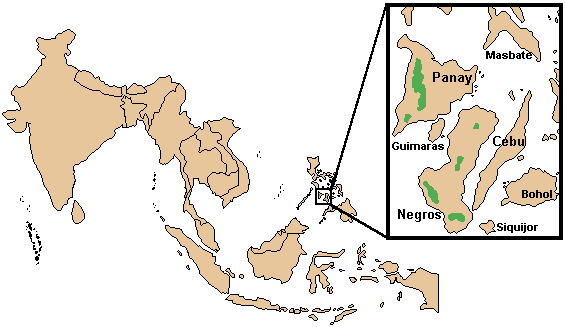Kingdom: |
Animalia Chordata Mammalia Artiodactyla Suiformes Suidae Suini Sus |
Common name:
Scientific name:
Other names:
|
Visayan warty pig
Sus cebifrons
Cebu bearded pig, Baboy ilahas, Baboy do mor, Baboy talunon, Manggalisak
banban, Biggal, Bakatin
|
Physical Characteristics
-
Head and body length: About 100 cm
- Shoulder height: 30-45 cm (females), up to 63 cm (males)
- Tail length: 23 cm
- Adult weight: 20-35 kg (females), 35-40 kg, up to 80 kg (males)
- Shoulder height: 30-45 cm (females), up to 63 cm (males)
The Visayan warty pig is a dark grey color, and the body is sparsely covered with bristly hairs (in females these bristles are usually dark, while males often have light brown or silvery bristles). There is a tuft of hair in between the ears; in adult males from the island of Panay, this tuft grows into a long mane which runs from the head to the tail and which may hang over the face, covering the eyes! Like all pigs, the face is long and ends with a round nasal disc. Although called a warty pig, facial warts of this species are small and only found in males. These pigs are best recognized by the white stripe which runs over the bridge of the nose behind the mouth.
Reproduction and Development
-
Gestation period: 118 days.
- Litter size: 2-4, with 3 being the average.
- Weaning: By six months.
- Sexual maturity: As young as 12-14 months in captivity, although 2-3 years is more typical.
- Life span: 10-15 years.
- Litter size: 2-4, with 3 being the average.
Piglets are usually born in January, February, and March (the dry season). Mother pigs usaully make a nest in which to give birth, and are very protective of their offspring. At birth, Visayan warty pigs are light brown in color, with four dark stripes running down the body from head to tail. These stripes fade as the infants grow, and adult coloration is reached at one year.
Ecology and Behavior
-
Family group: Family groups of 3-12+ animals, usually with a single
adult male, several adult females, and their offspring.
- Diet: Omnivorous; fruits, leaves, earthworms.
Habitat and Distribution

Conservation Status
-
IUCN Red List: Critically endangered (2008).
- CITES Listing: Not listed (2009).
- Threats: Habitat destruction, hunting by humans for meat, and domestic pigs (through the introduction of parasites and diseases, and hybridization with wild Visayan warty pigs).
- CITES Listing: Not listed (2009).
Numbers of wild Visayan warty pigs are not available, but the species has lost 95% of its former range in recent times and is highly endangered.






